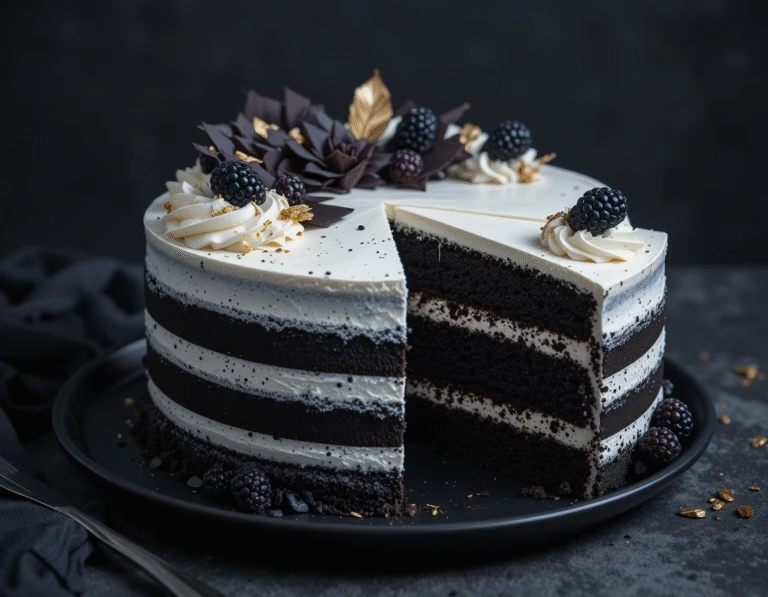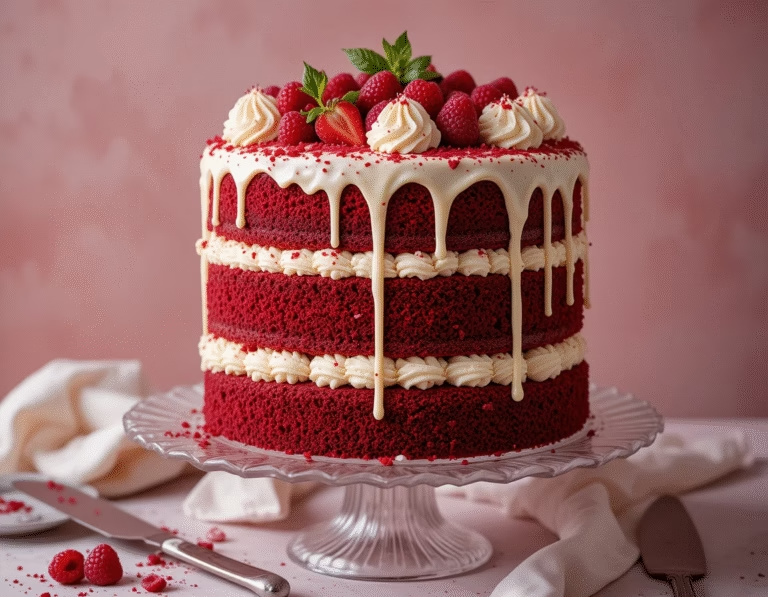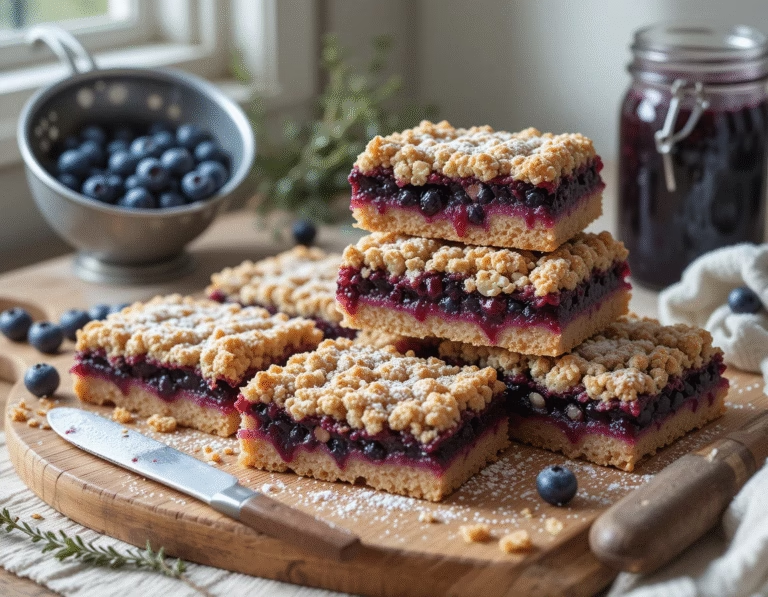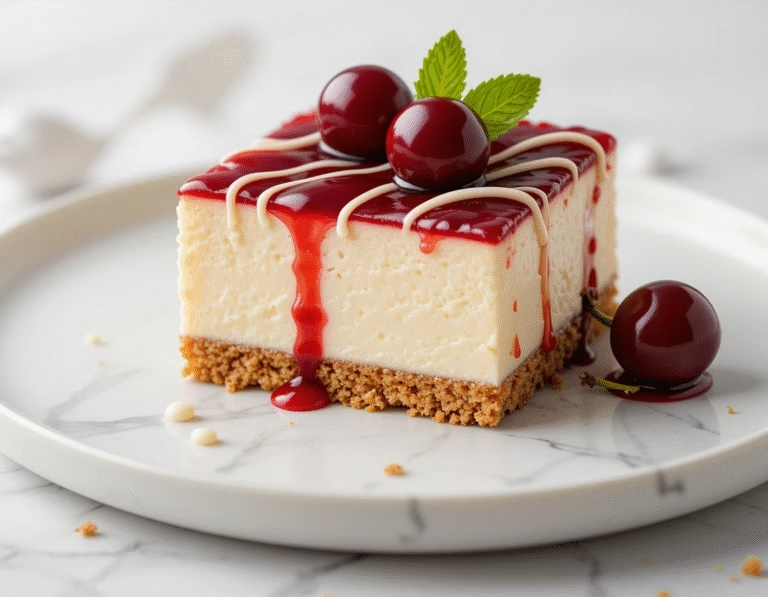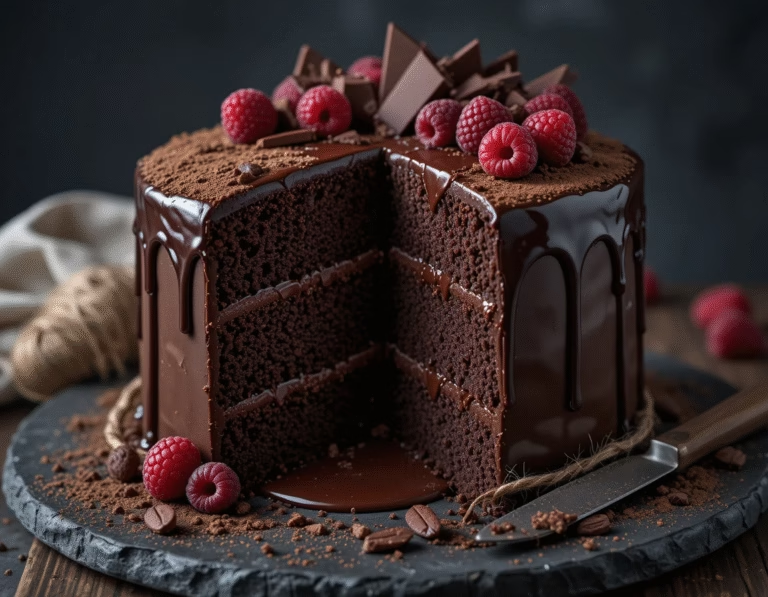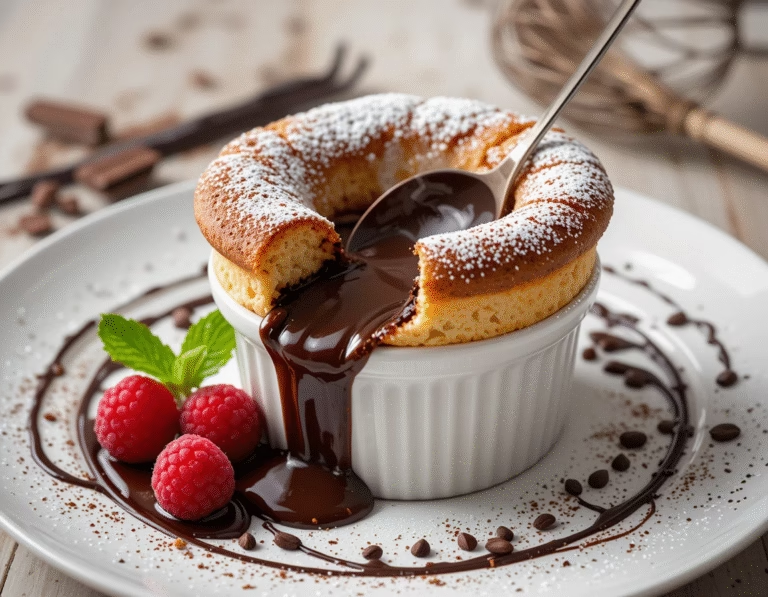Easy Chantilly Cake Recipe: Light & Creamy French Dessert
Chantilly cake recipe Few desserts capture the essence of elegance and indulgence quite like a Chantilly cake. With its tender sponge layers, lavish whipped cream frosting, and bursts of fresh fruit, this cake is a staple in Southern celebrations and an increasingly beloved choice across the U.S. The Chantilly cake manages to be both decadent and light, a rare combination that makes it perfect for birthdays, anniversaries, weddings, or simply to treat yourself on a sunny weekend. Originally inspired by the French term “crème Chantilly” (which simply means sweetened whipped cream), this American twist brings together layers of beauty and flavor that are anything but ordinary.
While many think of chocolate or red velvet cakes as their go-to for special occasions, the Chantilly cake stands out for its freshness and delicate complexity. It is typically made with moist vanilla or almond cake layers, filled and frosted with fluffy Chantilly cream—an ethereal blend of whipped cream, mascarpone, and cream cheese sweetened to perfection. Add to that a medley of berries like strawberries, raspberries, and blueberries, and you’ve got a showstopping dessert that tastes as good as it looks.
In recent years, the Chantilly cake has become a bakery favorite, often seen in high-end grocery stores and boutique cake shops. However, there’s nothing quite like making one at home. Not only do you get the satisfaction of creating something beautiful from scratch, but you also get to customize it to suit your tastes—perhaps with your favorite fruits or a touch more sweetness in the cream. Plus, when you make it yourself, you control every ingredient, ensuring it aligns with your dietary preferences—whether you want to reduce sugar, keep it alcohol-free, or use organic fruits and dairy.
This blog will guide you step-by-step through making a Chantilly cake that is just as gorgeous and delicious as those you see in bakeries, but tailored for the home cook. Whether you’re an experienced baker or a weekend kitchen warrior, you’ll find this recipe accessible and deeply rewarding. The ingredient list is straightforward, and the results are spectacular. So, get your mixer ready, stock up on berries, and let’s get started on crafting a Chantilly cake that’s as memorable to make as it is to eat.
What You’ll Need
To make a showstopping Chantilly cake, you’ll need a mix of fresh, high-quality ingredients and a few kitchen staples. What makes this cake truly shine is its combination of rich, creamy elements and light, fluffy textures. When choosing your ingredients, always opt for the best quality you can find—particularly when it comes to the cream, butter, and berries. Each component plays a crucial role in building the layers of flavor and texture that make this cake so special.
Dry Ingredients:
- 2 ½ cups (312g) all-purpose flour – This provides the base structure for your cake. Sift it beforehand to ensure a light, even crumb.
- 2 ½ tsp baking powder – This leavening agent gives the cake a nice rise.
- ½ tsp baking soda – Helps balance acidity and adds to the leavening.
- ½ tsp salt – Enhances the overall flavor without overpowering the sweetness.
Wet Ingredients:
- 1 cup (226g) unsalted butter, softened – Use high-quality butter for a rich, tender cake. Room temperature is key for even mixing.
- 2 cups (400g) granulated sugar – Provides sweetness and helps the cake develop a golden crust.
- 4 large eggs, room temperature – These bind the ingredients together and help with rise and structure.
- 1 tbsp pure vanilla extract – The foundation of flavor in both the cake and the cream.
- 1 cup (240ml) buttermilk – Adds a pleasant tang and helps keep the crumb moist and tender.
For the Chantilly Cream Frosting:
- 8 oz (226g) mascarpone cheese, cold – Gives the frosting richness and a luxurious mouthfeel.
- 8 oz (226g) cream cheese, cold – Adds stability and a slight tanginess to balance the sweetness.
- 2 cups (480ml) heavy whipping cream, cold – Whips into a light, airy texture.
- 1 cup (120g) powdered sugar – Sweetens the cream without making it gritty.
- 2 tsp pure vanilla extract – Enhances the creamy base with aromatic depth.
For the Fruit Filling and Decoration:
- 1 ½ cups fresh strawberries, sliced
- 1 cup fresh raspberries
- 1 cup fresh blueberries
- Optional: ½ cup peach or apricot preserves – Can be lightly brushed between layers for added flavor and moisture.
Equipment Needed:
- Three 8-inch round cake pans
- Parchment paper
- Hand or stand mixer
- Cooling racks
- Offset spatula
- Cake turntable (optional, but helpful)
- Serrated knife (for leveling cake layers, if needed)
Each ingredient and tool serves a purpose, and when used correctly, they all come together to create the perfect Chantilly cake. The cake layers are moist and delicate, the cream is rich yet airy, and the fruit brings a vibrant, fresh contrast that ties everything together. Having everything measured and prepped before you begin will make the process smooth and enjoyable. Think of this section as your mise en place—the foundation of a great baking session.
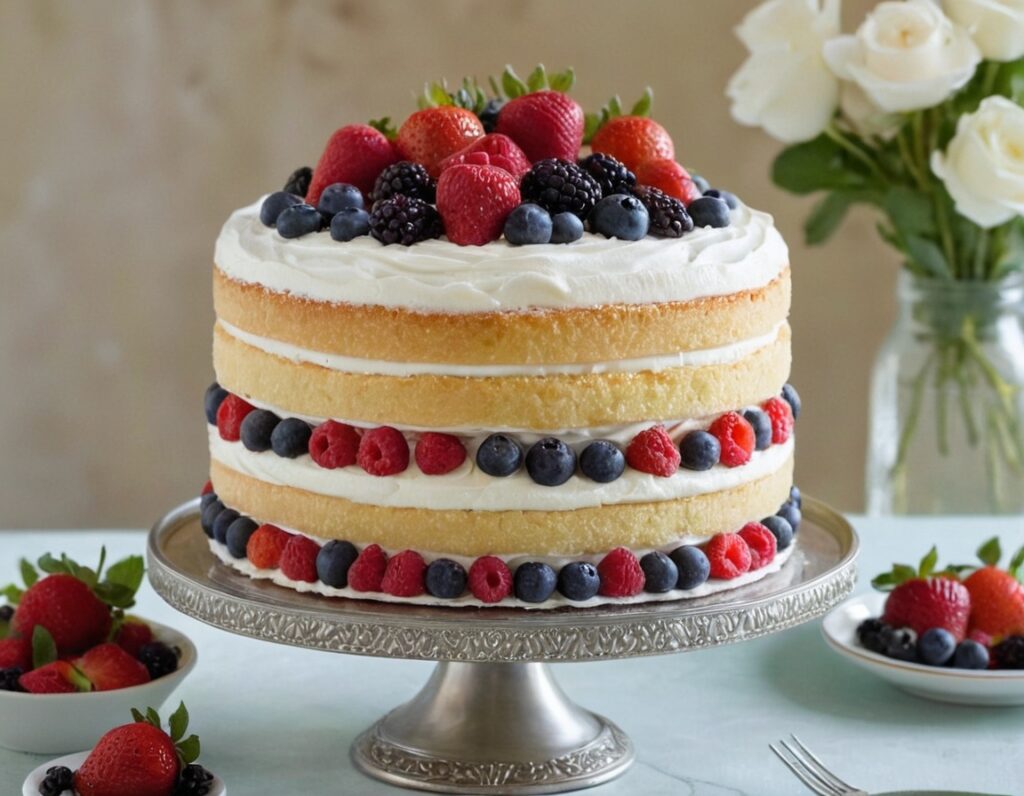
How to Make (include full measurements)
Making a Chantilly cake may seem intimidating at first glance, but it’s actually quite manageable when broken into steps. The key to success lies in preparing each component with care: moist vanilla cake layers, rich Chantilly cream, and fresh fruit for brightness and flavor. This guide walks you through the full process—from mixing the batter to final assembly—so you can confidently bake a cake that rivals any bakery’s.
Step 1: Prepare Your Cake Pans and Oven
Start by preheating your oven to 350°F (175°C). Grease three 8-inch round cake pans and line the bottoms with parchment paper to prevent sticking. Lightly flour the sides or use nonstick baking spray with flour included.
Step 2: Mix the Dry Ingredients
In a large bowl, sift together:
- 2 ½ cups (312g) all-purpose flour
- 2 ½ tsp baking powder
- ½ tsp baking soda
- ½ tsp salt
Whisk well to ensure even distribution and set aside.
Step 3: Cream the Butter and Sugar
In a stand mixer fitted with the paddle attachment, beat:
- 1 cup (226g) unsalted butter, room temperature
- 2 cups (400g) granulated sugar
Cream on medium-high speed for 3–5 minutes until light, fluffy, and pale in color. Scrape down the sides of the bowl as needed.
Step 4: Add the Eggs and Vanilla
Add one egg at a time:
- 4 large eggs, room temperature
Beat well after each addition. Then add:
- 1 tbsp pure vanilla extract
Mix until incorporated.
Step 5: Combine with Dry Ingredients and Buttermilk
With the mixer on low speed, alternately add the dry ingredients and:
- 1 cup (240ml) buttermilk
Start and end with the dry ingredients, mixing just until combined. Be careful not to overmix, or the cake may turn dense.
Step 6: Bake the Cake
Evenly divide the batter among the three prepared pans. Smooth the tops with an offset spatula. Bake for 22–26 minutes, or until a toothpick inserted into the center comes out clean. Allow the cakes to cool in their pans for 10 minutes before turning them out onto wire racks to cool completely.
Step 7: Make the Chantilly Cream
In a large mixing bowl, beat together:
- 8 oz (226g) cold mascarpone cheese
- 8 oz (226g) cold cream cheese
Beat until smooth. Add:
- 2 tsp pure vanilla extract
- 1 cup (120g) powdered sugar
Beat until incorporated, then slowly add:
- 2 cups (480ml) cold heavy whipping cream
Continue whipping until stiff peaks form. Do not overbeat.
Step 8: Prepare the Fruit
Wash, dry, and slice:
- 1 ½ cups fresh strawberries
- 1 cup fresh raspberries
- 1 cup fresh blueberries
Optional: Heat ½ cup peach or apricot preserves in the microwave for 10 seconds and strain to remove chunks. Brush lightly over each cake layer before assembling for added moisture.
Step 9: Assemble the Cake
Place one cake layer on your serving platter or cake turntable. Spread a generous layer of Chantilly cream on top, then a handful of mixed berries. Repeat with the second layer. For the top layer, add cream, arrange berries decoratively, and smooth the sides for a semi-naked finish or frost fully.
Step 10: Chill and Serve
Chill the assembled cake in the refrigerator for at least 1 hour before serving. This helps the cream set and makes slicing cleaner.
Serving and Storage Tips
Once your beautiful Chantilly cake is complete, you’ll want to make sure it’s served at its best and stored properly to maintain its delicate textures and fresh flavors. Because this cake features whipped cream and fresh fruit, handling it with care is essential. Unlike sturdier, buttercream-frosted cakes, Chantilly cakes are more sensitive to temperature and moisture. Let’s walk through how to serve and store it effectively so you and your guests can enjoy every last bite.
Serving Tips
1. Chill Before Slicing:
After assembling your cake, it’s important to refrigerate it for at least 1 hour. This allows the Chantilly cream to set, the layers to firm up, and the fruit to integrate with the cake without sliding around. If possible, assemble the cake 2–4 hours ahead of serving.
2. Use a Serrated Knife:
Use a long, sharp serrated knife to cut through the cake layers smoothly without squishing them. Wipe the knife between each slice to keep the presentation clean.
3. Serve Slightly Chilled:
Although it should be stored cold, this cake tastes best when served slightly chilled but not too cold. Let slices rest at room temperature for 10–15 minutes before serving. This allows the mascarpone and cream cheese to soften slightly and bring out their full flavor.
4. Garnish Before Serving (Optional):
For an extra-fancy touch, garnish individual slices with a few fresh berries and a dusting of powdered sugar just before serving. You could also pipe decorative swirls of Chantilly cream for a bakery-worthy look.
Storage Tips
1. Store in the Refrigerator:
Due to the fresh fruit and whipped cream content, Chantilly cake must be stored in the refrigerator. Place the cake in an airtight container or cover it loosely with plastic wrap or a cake dome. This prevents the cream from absorbing fridge odors and keeps the fruit from drying out.
2. Consume Within 2–3 Days:
This cake is best enjoyed fresh. Over time, the whipped cream may lose its firmness and the fruit may begin to release juices that can affect the texture of the cake layers. Try to consume within 48–72 hours for optimal flavor and presentation.
3. Avoid Freezing Fully Assembled Cake:
While you can freeze the plain cake layers ahead of time (wrap them well and freeze for up to 2 months), avoid freezing the entire assembled cake. The cream may separate and fruit may become mushy once thawed. However, leftover slices can be individually frozen if necessary—just be prepared for some texture change.
4. Transport with Care:
If taking your Chantilly cake to an event, be sure to keep it cool during transit. A cooler with ice packs or a thermal bag helps maintain temperature. Avoid leaving it in a warm car or sunlit area.
5. Refreshing Leftovers:
If you find that the cream has softened after a day or two, you can give the cake a mini refresh. Top with a little freshly whipped cream or add a few new berries before serving again.
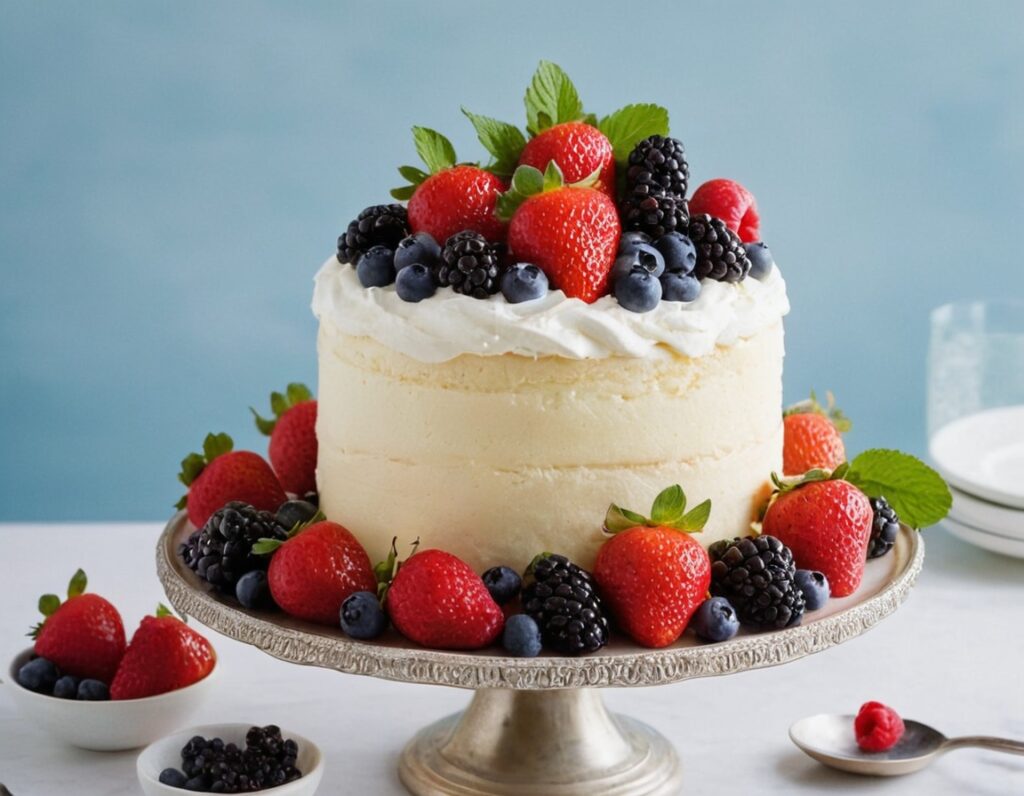
Mistakes to Avoid
Even the most experienced bakers can run into trouble when making a Chantilly cake. While the recipe may appear straightforward, there are a number of delicate steps and choices that can make or break the final result. Chantilly cake is all about balance—light textures, rich cream, and fresh fruit. That balance can easily be thrown off by common mistakes, from improper mixing to poor storage. Here’s a breakdown of the most frequent issues and how you can avoid them to ensure a bakery-worthy outcome every time.
1. Overmixing the Cake Batter
One of the most common mistakes is overmixing the batter after the flour has been added. Overworking the batter develops the gluten too much, resulting in a dense or rubbery cake rather than a soft, tender crumb. To avoid this, mix just until the dry ingredients are incorporated and no more. Scrape the bowl as needed, but don’t overdo it.
2. Using Warm Cream for the Frosting
Chantilly cream relies on cold ingredients—especially the mascarpone, cream cheese, and heavy cream—to whip up properly. If any of these are too warm, your cream may not hold peaks or may even separate. Always use cold cream straight from the fridge and chill your mixing bowl and beaters beforehand for best results.
3. Layering While the Cake Is Still Warm
Attempting to frost or assemble the cake while the layers are still warm is a guaranteed way to melt your Chantilly cream and create a sloppy, unstable cake. Make sure the cake layers are completely cooled, preferably for at least an hour, before adding any filling or frosting.
4. Skipping the Parchment Paper
It may seem like an optional step, but lining your cake pans with parchment paper can mean the difference between perfectly released layers and a crumbling disaster. Always trace and cut parchment rounds for the pan bottoms and lightly grease the sides for a clean release.
5. Not Draining Wet Fruit
Fresh berries can be juicy—especially after washing—and if not properly dried, the moisture can seep into your cake layers or cream, creating soggy patches. After rinsing your fruit, be sure to dry them well with paper towels. You can also gently pat sliced strawberries to reduce excess moisture.
6. Overloading the Cake with Fruit
While fruit adds vibrant flavor and beauty, too much can weigh down the layers or cause them to shift. Avoid overloading the middle layers with berries. Instead, add a modest amount between each layer and save the bulk of the fruit for the top as decoration.
7. Frosting a Crumbly Cake
If your cake layers aren’t leveled or have loose crumbs, you may end up with a speckled appearance in your cream frosting. Consider doing a thin crumb coat—just a very light layer of cream over the whole cake—and then refrigerate it for 20 minutes before applying the final layer.
8. Improper Storage
Leaving a Chantilly cake out at room temperature for extended periods will compromise the frosting and fruit. Always refrigerate when not serving, and be mindful of time out on the counter—ideally no more than 1–2 hours.
By keeping these pitfalls in mind and practicing patience, you’ll avoid the most common Chantilly cake mishaps. Each of these mistakes is easily fixable with the right techniques, ensuring that your cake is not only beautiful but also deliciously light and balanced.
Tips and Tricks
Even though Chantilly cake is a showstopper, it doesn’t require professional training to master. With a few smart baking tips and helpful tricks, you can ensure your homemade version turns out just as stunning as any bakery display. From making the fluffiest whipped cream to maximizing flavor, here are some tried-and-true insights to elevate your Chantilly cake to the next level.
1. Chill All Frosting Equipment
This may sound excessive, but chilling your mixing bowl, beaters, and even the cream cheese and mascarpone before whipping helps the Chantilly cream hold stiff peaks. Whipped cream is very temperature-sensitive. A cold environment will give you maximum volume and help prevent separation.
2. Use Cake Strips for Even Layers
To achieve flat, evenly baked cake layers without domed tops, wrap your pans with wet cake strips. These reusable fabric bands are soaked in water and wrapped around the outside of the pans. They slow the baking on the outside edges and result in more level cakes—no trimming needed.
3. Make It Ahead
The cake layers can be made a day in advance, wrapped tightly in plastic wrap, and stored at room temperature or refrigerated. You can also make the Chantilly cream the day you assemble the cake, which saves time and ensures freshness.
4. Add Citrus Zest for Brightness
If you want to add another layer of flavor to your Chantilly cream, try mixing in a teaspoon of lemon or orange zest. The subtle citrus undertone pairs beautifully with the berries and enhances the overall freshness of the cake.
5. Stabilize the Cream (Optional)
If you need the cream to hold up longer for a party or event, you can stabilize it with a bit of gelatin or instant pudding mix. For gelatin, dissolve 1 tsp powdered gelatin in 1 tbsp cold water, let it bloom, then melt it and mix into the cream while whipping. For pudding mix, 1–2 tablespoons of instant vanilla pudding added to the cream as it whips helps it hold its shape longer.
6. Customize the Fruit
While berries are traditional, you can use other fruits as well. Sliced kiwi, mango, mandarin oranges, or peaches work well—just make sure they’re not too wet. Avoid canned fruits packed in syrup unless they are well-drained and patted dry.
7. Use a Turntable for Smooth Frosting
If you plan on frosting the sides and top of the cake for a clean look, a rotating cake turntable is your best friend. It allows you to spin the cake as you apply the frosting, helping you achieve smooth, even layers with less effort.
8. Add a Preserve Glaze for Shine
To give your fruit topping a bakery-style finish, lightly brush the berries with warm apricot or peach preserves. This adds shine and prevents the fruit from drying out while sitting on the cake.
These tips are designed to help you work smarter, not harder, while baking. Whether you’re making a Chantilly cake for a special celebration or just want to try something new in the kitchen, these small adjustments can make a big difference in the final product.
Suggestions
When it comes to Chantilly cake, the beauty lies in its versatility. While the classic recipe is a fantastic dessert on its own, there are numerous ways you can personalize and elevate your cake to suit different occasions, flavor preferences, or dietary needs. Whether you want to add new flavor twists, make it kid-friendly, or incorporate seasonal ingredients, these suggestions will inspire you to make your Chantilly cake truly your own.
Flavor Variations to Try
The base of Chantilly cake—vanilla sponge with rich mascarpone and whipped cream—pairs wonderfully with many flavors. For a twist, consider infusing your cake layers or cream with:
- Citrus: Add fresh lemon or orange zest to the cake batter for a bright, fresh note. You can also add a splash of orange blossom water or lemon extract to the Chantilly cream for an aromatic boost.
- Almond or Coconut: Substitute some of the flour with finely ground almond meal or add shredded coconut to the batter. Top the cake with toasted almonds or coconut flakes for texture.
- Chocolate: For chocolate lovers, swirl in some cocoa powder into the batter or layer in thin sheets of chocolate ganache between cake layers. Chocolate Chantilly cream, made by folding in melted chocolate, is another decadent option.
Seasonal Fruit Options
While fresh berries are the traditional topping, Chantilly cake lends itself beautifully to other fruits depending on the season. In summer, use juicy peaches, nectarines, or cherries. In fall, try sliced pears or spiced apples with a sprinkle of cinnamon. Winter options include pomegranate seeds or blood oranges.
Dietary Adjustments
If you have guests with dietary restrictions or preferences, Chantilly cake can be adapted:
- Gluten-Free: Use a gluten-free flour blend designed for baking. Make sure to check that your baking powder is gluten-free.
- Dairy-Free: Swap mascarpone and cream cheese with plant-based alternatives such as coconut cream or cashew cream. Use non-dairy whipping cream to maintain the whipped texture.
- Lower Sugar: Reduce the sugar in the cake and Chantilly cream slightly or substitute with natural sweeteners like honey or maple syrup, adjusting for sweetness.
Presentation Ideas
The visual appeal of Chantilly cake is one of its biggest draws. Some ideas for presentation include:
- Semi-Naked Cake: Leave the sides only lightly frosted for a rustic yet elegant look that shows off the layers.
- Decorative Piping: Use a piping bag with a star tip to pipe rosettes or swirls of Chantilly cream around the edges or top of the cake.
- Fresh Herb Garnish: Add a sprig of mint, basil, or edible flowers on top for a fresh, garden-inspired touch.
Occasion Ideas
Chantilly cake is perfect for celebrations, afternoon tea, or even just a weekend treat. It’s light enough to serve after a heavy meal but luxurious enough to feel special. It pairs wonderfully with a cup of coffee, tea, or sparkling non-alcoholic cider for toasts.
FAQ
1. What is Chantilly cream?
Chantilly cream is a sweetened whipped cream, traditionally flavored with vanilla. In this recipe, it is enriched with mascarpone and cream cheese, which add creaminess and stability, making it perfect for frosting cakes and layering with fruit.
2. Can I use regular whipped cream instead of Chantilly cream?
Regular whipped cream can be used, but it may not be as stable or rich as Chantilly cream made with mascarpone and cream cheese. The Chantilly cream holds its shape longer and has a more luxurious texture and flavor.
3. How long does Chantilly cake last?
Because of the fresh cream and fruit, it’s best to consume Chantilly cake within 2–3 days. Always store it refrigerated in an airtight container or under a cake dome.
4. Can I make Chantilly cake ahead of time?
Yes! You can bake the cake layers up to two days in advance and store them tightly wrapped at room temperature or in the fridge. The Chantilly cream is best made the day of assembly, but can be whipped a few hours in advance and kept refrigerated.
5. Can I freeze Chantilly cake?
It’s not recommended to freeze the fully assembled Chantilly cake because the cream can separate and the fruit may become soggy after thawing. However, you can freeze individual cake layers before assembly for up to two months.
6. How do I keep the Chantilly cream from melting?
Use very cold mascarpone, cream cheese, and heavy cream when whipping. Chill your mixing bowl and beaters as well. After assembling the cake, keep it refrigerated until serving. You can also stabilize the cream with gelatin if needed for longer hold.
7. What fruits work best for Chantilly cake?
Fresh berries like strawberries, raspberries, blueberries, and blackberries are classic choices. Other fruits like peaches, kiwi, mango, or pomegranate seeds also work well. Avoid overly juicy or watery fruits that might make the cake soggy.
8. Can I make this cake dairy-free?
Yes! Use dairy-free cream cheese and mascarpone alternatives and non-dairy whipping cream. Adjust whipping times as some dairy-free creams can behave differently.
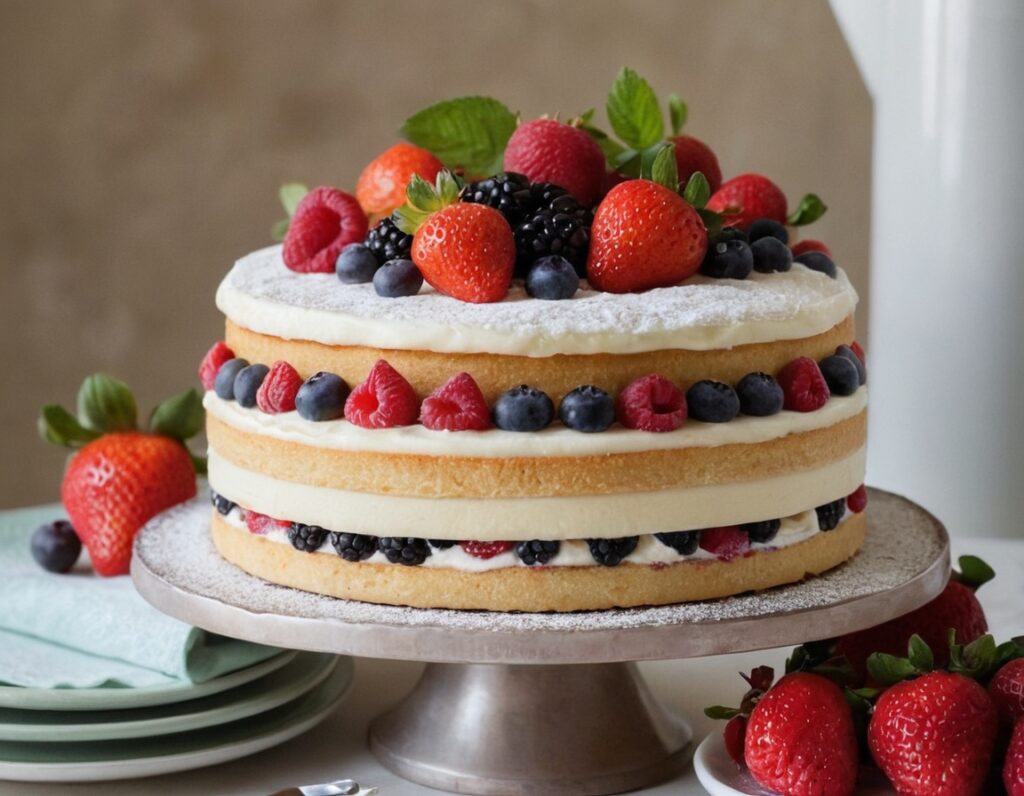
Conclusion
The Chantilly cake is a timeless dessert that perfectly blends lightness and indulgence into every bite. With its delicate vanilla sponge, luxuriously creamy Chantilly frosting, and fresh, juicy fruit, this cake is a true celebration of classic French patisserie technique adapted for any home kitchen. Whether you’re making it for a special occasion, a family gathering, or simply to enjoy a slice of something truly delightful, mastering this cake will elevate your baking skills and impress everyone lucky enough to try it.
One of the most beautiful aspects of Chantilly cake is its versatility. The fundamental recipe provides a reliable, delicious foundation, but there’s ample room to make it your own. You can experiment with seasonal fruits, infuse your cream with subtle flavorings, or adjust the sweetness and texture to fit your taste or dietary preferences. This adaptability makes it not only a fantastic dessert option year-round but also a personal canvas for your creativity in the kitchen.
Throughout this blog post, we’ve explored every facet of crafting the perfect Chantilly cake—from the essential ingredients and step-by-step instructions to the common mistakes you should avoid and the helpful tips and tricks that make all the difference. We’ve also covered suggestions for customizing the cake and answered common questions to empower you with confidence as you bake.
Remember that successful baking requires patience and attention to detail, especially with delicate desserts like Chantilly cake. Take your time with each step, especially whipping the cream to the perfect consistency and allowing the cake layers to cool completely before assembly. Use the suggestions to tailor the cake to your liking, and don’t be afraid to try new variations to find your signature style.
Finally, serving and storing the cake properly ensures that each slice tastes as fresh and delicious as the first. Chantilly cake is best enjoyed within a few days of preparation, stored carefully in the refrigerator, and shared with loved ones who will appreciate its elegance and flavor.
In conclusion, this Chantilly cake recipe is more than just a dessert—it’s an experience of texture, flavor, and presentation that captures the joy of homemade baking. With the knowledge and tips provided, you’re well-equipped to create a stunning cake that tastes as wonderful as it looks. Happy baking, and enjoy every luscious bite!


